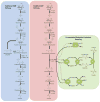Physiological, metabolic and biotechnological features of extremely thermophilic microorganisms
- PMID: 28206708
- PMCID: PMC5400732
- DOI: 10.1002/wsbm.1377
Physiological, metabolic and biotechnological features of extremely thermophilic microorganisms
Abstract
The current upper thermal limit for life as we know it is approximately 120°C. Microorganisms that grow optimally at temperatures of 75°C and above are usually referred to as 'extreme thermophiles' and include both bacteria and archaea. For over a century, there has been great scientific curiosity in the basic tenets that support life in thermal biotopes on earth and potentially on other solar bodies. Extreme thermophiles can be aerobes, anaerobes, autotrophs, heterotrophs, or chemolithotrophs, and are found in diverse environments including shallow marine fissures, deep sea hydrothermal vents, terrestrial hot springs-basically, anywhere there is hot water. Initial efforts to study extreme thermophiles faced challenges with their isolation from difficult to access locales, problems with their cultivation in laboratories, and lack of molecular tools. Fortunately, because of their relatively small genomes, many extreme thermophiles were among the first organisms to be sequenced, thereby opening up the application of systems biology-based methods to probe their unique physiological, metabolic and biotechnological features. The bacterial genera Caldicellulosiruptor, Thermotoga and Thermus, and the archaea belonging to the orders Thermococcales and Sulfolobales, are among the most studied extreme thermophiles to date. The recent emergence of genetic tools for many of these organisms provides the opportunity to move beyond basic discovery and manipulation to biotechnologically relevant applications of metabolic engineering. WIREs Syst Biol Med 2017, 9:e1377. doi: 10.1002/wsbm.1377 For further resources related to this article, please visit the WIREs website.
© 2017 Wiley Periodicals, Inc.
Figures





References
-
- Setchell WA. The upper temperature limits of life. Science. 1903;17:934–937. - PubMed
-
- Zillig W, et al. The Sulfolobus-‘Caldariella’ group: taxonomy on the basis of the structure of DNA-dependent RNA polymerases. Arch Microbiol. 1980;125:259–269.
-
- Stetter KO, Lauerer G, Thomm M, Neuner A. Isolation of extremely thermophilic sulfate reducers: evidence for a novel branch of archaebacteria. Science. 1987;236:822–824. - PubMed
-
- Huber G, Spinnler C, Gambacorta A, Stetter KO. Metallosphaera sedula gen and sp nov represents a new genus of aerobic, metal-mobilizing, thermoacidophilic archaebacteria. Syst Appl Microbiol. 1989;12:38–47.
Publication types
MeSH terms
Substances
Grants and funding
LinkOut - more resources
Full Text Sources
Other Literature Sources

